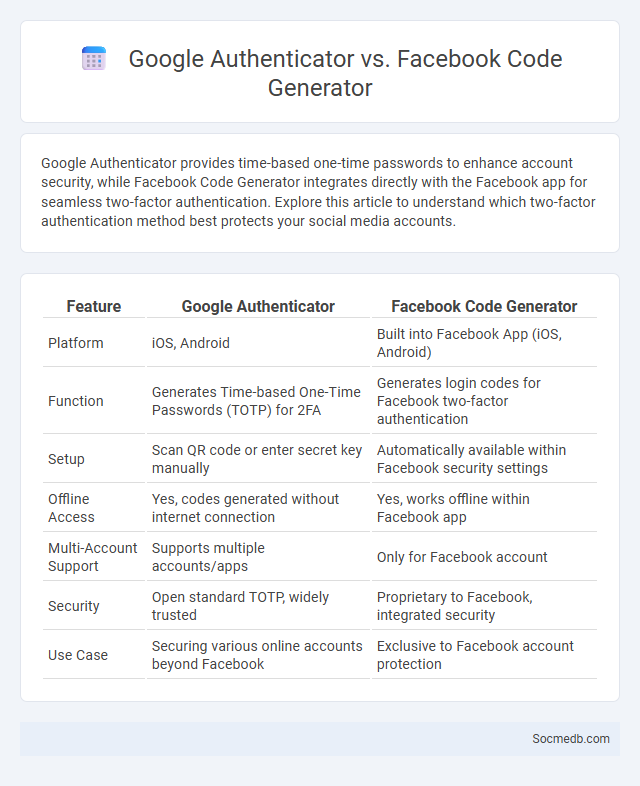
Photo illustration: Google Authenticator vs Facebook Code Generator
Google Authenticator provides time-based one-time passwords to enhance account security, while Facebook Code Generator integrates directly with the Facebook app for seamless two-factor authentication. Explore this article to understand which two-factor authentication method best protects your social media accounts.
Table of Comparison
| Feature | Google Authenticator | Facebook Code Generator |
|---|---|---|
| Platform | iOS, Android | Built into Facebook App (iOS, Android) |
| Function | Generates Time-based One-Time Passwords (TOTP) for 2FA | Generates login codes for Facebook two-factor authentication |
| Setup | Scan QR code or enter secret key manually | Automatically available within Facebook security settings |
| Offline Access | Yes, codes generated without internet connection | Yes, works offline within Facebook app |
| Multi-Account Support | Supports multiple accounts/apps | Only for Facebook account |
| Security | Open standard TOTP, widely trusted | Proprietary to Facebook, integrated security |
| Use Case | Securing various online accounts beyond Facebook | Exclusive to Facebook account protection |
Introduction to Two-Factor Authentication
Two-factor authentication (2FA) enhances social media security by requiring two forms of verification: something you know, like a password, and something you have, such as a mobile device or authentication app. This added layer protects your accounts from unauthorized access, even if your password is compromised. Implementing 2FA on platforms like Facebook, Instagram, and Twitter significantly reduces the risk of hacking and identity theft.
What Is Google Authenticator?
Google Authenticator is a security application that generates time-based one-time passwords (TOTPs) to enhance your social media accounts' protection against unauthorized access. It provides an extra layer of two-factor authentication (2FA) by requiring a unique code in addition to your regular password during login. Using Google Authenticator significantly reduces the risk of account breaches caused by phishing or password theft.
Understanding Facebook Code Generator
Facebook Code Generator enhances your account security by providing unique, time-sensitive login codes via the Facebook app, eliminating reliance on SMS for two-factor authentication. This feature generates temporary numeric codes that must be entered during login attempts, ensuring that only authorized users can access your profile. Your proactive use of the Facebook Code Generator significantly reduces the risk of unauthorized access and keeps your social media presence secure.
Key Features Comparison
Social media platforms vary widely in their key features, with Facebook emphasizing community building through groups and events, Instagram focusing on visual content sharing and Stories, and Twitter prioritizing real-time news updates and microblogging. TikTok stands out with its short-form video creation tools and algorithm-driven content discovery, while LinkedIn targets professional networking with resume showcasing and job posting capabilities. Understanding these distinct functionalities helps users and marketers optimize engagement and content strategy across different platforms.
Security Strength: Google Authenticator vs Facebook Code Generator
Google Authenticator offers enhanced security strength by generating time-based one-time passwords (TOTPs) that are resistant to phishing and replay attacks, providing a robust layer of two-factor authentication for your online accounts. Facebook Code Generator, integrated within the Facebook app, simplifies login but relies on push notifications that can be susceptible to SIM swapping and device compromises. Choosing Google Authenticator significantly improves your account protection by minimizing vulnerabilities associated with code delivery methods.
User Experience and Ease of Use
Social media platforms prioritize seamless user experience by offering intuitive interfaces that simplify content creation and interaction. Features such as personalized feeds, easy navigation, and responsive design enhance user engagement and accessibility across devices. Streamlined onboarding processes and clear privacy settings contribute to user satisfaction and trust.
Supported Platforms and Integration
Supported platforms for social media include Facebook, Instagram, Twitter, LinkedIn, TikTok, and Pinterest, enabling seamless content sharing and audience engagement across diverse channels. Integration tools such as Hootsuite, Buffer, and Zapier allow you to manage multiple accounts, schedule posts, and analyze performance from a single dashboard. Your brand's reach and efficiency improve significantly by leveraging these platforms and integration capabilities for cohesive social media strategies.
Backup and Recovery Options
Social media platforms implement robust backup and recovery options to protect user data from loss due to cyberattacks, technical failures, or accidental deletion. These systems often include automated cloud-based backups, encrypted storage, and versioning capabilities to ensure swift data restoration and minimize downtime. Employing multi-region data replication and regular testing of recovery protocols enhances resilience and maintains platform reliability.
Pros and Cons of Each Method
Social media platforms like Facebook, Instagram, Twitter, LinkedIn, and TikTok offer unique benefits and drawbacks; Facebook excels in community building but can expose you to privacy issues, while Instagram focuses on visual content yet may promote unrealistic lifestyle standards. Twitter provides real-time updates and networking opportunities but often faces criticism for misinformation and limited character space, whereas LinkedIn is optimal for professional growth though can feel overly formal. TikTok's algorithm drives viral engagement but may contribute to short attention spans; understanding these nuances helps you leverage the right platform for your goals effectively.
Which Two-Factor Authentication Tool Should You Choose?
Choosing the right two-factor authentication (2FA) tool depends on security features, ease of use, and compatibility across devices. Authenticator apps like Google Authenticator and Authy offer time-based one-time passwords (TOTP) with strong encryption, while hardware tokens such as YubiKey provide physical security resistant to phishing attacks. Evaluate tools based on multi-device support, offline functionality, and integration with your social media platforms to ensure both convenience and robust protection.
 socmedb.com
socmedb.com